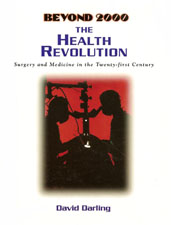THE HEALTH REVOLUTION: Surgery and Medicine in the Twenty-first Century - Introduction
In times past the more blood a surgeon got on his gown, the more highly he was regarded. Since there were no anesthetics to numb patients or make them unconscious, even simple operations were incredibly painful. Surgeons worked as fast as they could in an effort to prevent their patients simply dying of shock. Often, the surgeons took gruesome pride in being able to saw off diseased limbs in a matter of seconds. This earned them the common nickname "sawbones." A range of primitive-looking tools that would have seemed more at home in a butcher's hands were all that the surgeon had to work with, and cleanliness was considered unimportant. Many patients who survived their operations died shortly afterward because their wounds became infected.
Thankfully, the days of the sawbones are long gone. Patients today are given effective anesthetics, and operating rooms are kept scrupulously clean. Surgical personnel wear sterilized gowns, masks, and boots, and go through a meticulous "scrubbing up" procedure before donning sterile surgical gloves. All instruments are made germ-free by being placed in an autoclave, a small oven that bathes them in super-hot stem.
But until recently many of the tools of the early surgeons – with minor improvements – were still used for most operations. Only with the last 15 years or so has surgery begun to be transformed by high-technology devices. Among these are precision lasers for making bloodless cuts, special flexible probes and tools that can be passed through button-sized holes into the patient's body, and instruments for doing operations on a microscopic scale.
Other breakthroughs have been made in the field of spare-part surgery. Every year, doctors replace an increasing number of body parts with artificial substitutes. The techniques for carrying out organ transplants are also being improved and extended.
Great strides have been made in the methods and machinery designed to save people's lives. And some particularly exciting developments have taken place in the technology of scanning equipment used to look closely at internal parts of the human body for early signs of diseases such as cancer.
Not surprisingly, given these advances, surgeons today can successfully operate to cure all sorts of complaints that not so long ago would have been difficult or impossible to treat. Many more advancements in surgery will take place in the years ahead as new instruments, materials, and techniques are developed. The revolution in the hospital and the operating room has just begun.

